|
|
|
 |
 |
 |
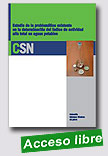 |
Estudio de la problemática existente en la determinación del índice de actividad alfa total en aguas potables
Consejo de Seguridad Nuclear, 2014, 176 p.
El objetivo fundamental del presente estudio es el de analizar en profundidad e identificar las causas que originan las variabilidades que actualmente aquejan a los procedimientos más frecuentemente utilizados para la determinación del índice de actividad alfa total en muestras de agua. Concretamente, los que pueden identificarse como los procedimientos de desecación, con medida en un contador proporcional de flujo de gas o en un contador de centelleo
|
sólido, de coprecipitación, con medida en un contador proporcional de flujo de gas o en un contador de centelleo sólido, y el de concentración, con medida por centelleo líquido. A partir del estudio aquí efectuado, se han propuesto unas nuevas redacciones de los procedimientos de desecación y coprecipitación existentes, publicados por el Consejo de Seguridad Nuclear (CSN, 2005), con bastante más detalle del que actualmente poseen, basados en el amplio soporte experimental surgido como consecuencia de la ejecución
del presente estudio y en el que sustentan todas las concreciones que en ellos se realizan. Así mismo, este estudio ha permitido la elaboración de un nuevo procedimiento para la determinación de los índices de actividad alfa total y beta total por concentración de la muestra y posterior medida por centelleo líquido.
De esta forma, con la nueva versión propuesta para los antes tres citados procedimientos, se logra acotar lo más razonablemente posible la antes mencionada variabilidad, garantizando además que las actividades que se obtienen como consecuencia de su aplicación, son suficientemente representativas de las realmente existentes en las aguas analizadas.
Extraído de:
http://www.csn.es/images/stories/publicaciones/unitarias
/informes_tecnicos/determinacion_alfa_aguas_potables_web.pdf |
 |
 |
Climate Change and Nuclear Power 2014
IAEA Non-serial Publications, 2014, 114 p.
Climate change is the foremost global environmental issue today. Nuclear power is one of the low carbon technologies that can contribute to reducing greenhouse gas emissions while delivering energy in the increasingly large quantities needed for growing populations and socioeconomic development.
Nuclear power plants produce virtually no greenhouse gas emissions or air pollutants during their operation and only very
|
low emissions over their entire life cycle. Nuclear power fosters energy supply security and industrial development by providing electricity reliably at stable and foreseeable prices.
The accident at the Fukushima Daiichi nuclear power plant in March 2011 caused deep public anxiety and raised fundamental questions about the future of nuclear energy throughout the world. It was a wake-up call for everyone involved in nuclear power — a reminder that safety can never be taken for granted. Yet, more than three years after the accident, it is clear that nuclear energy will remain an important option for many countries. Its advantages in terms of climate change mitigation are an important reason why many countries intend to introduce nuclear power in the coming decades, or to expand existing programmes. All countries have the right to use nuclear technology for peaceful purposes, as well as the responsibility to do so safely and securely.
The IAEA provides assistance and information to countries that wish to introduce nuclear power. It also provides information for broader audiences engaged in energy, environmental and economic policy making.
This report provides a comprehensive review of the potential role of nuclear power in mitigating global climate change and its contribution to other development and environmental challenges. The report also examines broader issues relevant to the climate change–nuclear energy nexus, such as costs, investments, financing, safety, waste management and non-proliferation. Recent developments in resource supply, changes in energy markets and technological developments are also presented.
Extraído de: http://www-pub.iaea.org/MTCD/Publications/PDF/ccanp2014web-14869824.pdf
|
 |
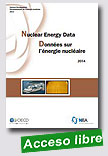 |
Nuclear Energy Data 2014
Nuclear Energy Agency (NEA), 2014, 99 p.
Nuclear Energy Data is the OECD Nuclear Energy Agency's annual compilation of statistics and country reports documenting the status of nuclear power in the OECD area. Information provided by member country governments includes statistics on installed generating capacity, total electricity produced by all sources and by nuclear power, nuclear energy policies and fuel cycle developments, as well as projected generating capacity and electricity production to |
2035, where available. Total electricity generation at nuclear power plants and the share of electricity production from nuclear power plants remained steady in 2013 despite the progressive shutdown of all reactors in Japan leading up to September and the permanent closure of six reactors in the OECD area.
Extraído de: http://www-pub.iaea.org/MTCD/Publications/PDF/INES_web.pdf |
 |
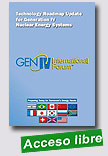 |
This technology roadmap update provides an assessment of progress made by the Generation IV International Forum (GIF) in the development of the six systems selected when the original technology roadmap was published in 2002. More importantly, it provides an overview of the major R&D objectives and milestones for the coming decade, aiming to achieve the Generation IV goals of sustainability, safety and reliability, economic competitiveness, proliferation resistance and physical protection.
|
Extraído de: http://www.oecd-nea.org/pub/
|
 |
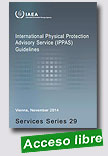 |
International Physical Protection Advisory Service (IPPAS) Guidelines
IAEA Services Series, 2014, 252 p..
The key objectives of the International Physical Protection Advisory Service (IPPAS) programme are to provide advice to: The national competent authorities (such as relevant regulatory bodies, law enforcement agencies, customs and border agencies and coast guards, intelligence agencies, response organizations, judicial entities) and operators, carriers and other regulated entities based on an objective assessment of the status of the nuclear security regime
|
through an evaluation of the implementation of international instruments, IAEA guidance and taking account of international good practices; Operators and shippers and/or carriers on their physical protection systems and various methods by which international recommendations and good practices can be satisfied; Key staff of the national competent authorities, operators and shippers and/or carriers with an opportunity to discuss their practices with the team of international experts who have experience in the field.
Additionally, the IPPAS team promotes the identification, in the course of the mission, of good practices that could be communicated to other Member States for long term improvement. The nuclear security specialists who participate on the IPPAS teams also have opportunities to broaden their experience and knowledge in their own field.
IPPAS is intended to be a peer review of the State nuclear security regime conducted by a team of international nuclear security and other relevant experts who will also use their extensive experience and international guidance to suggest improvements to that system. Judgments are made on the basis of the combined expertise of the international team.
Extraído de: http://www-pub.iaea.org/MTCD/Publications/PDF/IAEA-SVS-29_web.pdf
|
 |
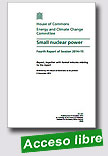
|
Small nuclear power - Fourth Report of Session 2014–15
House of Commons - Energy and Climate Change Committee (UK), 9 December 2014, 32 p.
Small nuclear reactors - those that produce the equivalent electric power of less than 300 MWe - potentially have many useful applications. These reactors include a variety of designs and technologies that can be categorised in numerous ways. One grouping of particular interest is ‘small modular reactors’ (SMRs), which are designed in a way that allows them to be manufactured at a plant, brought to site fully |
constructed, and installed module by module, thereby potentially improving manufacturing efficiency and cost while reducing construction time and financing costs.
While we recognise that the nuclear industry’s immediate priority is rightly the successful delivery of the UK’s current conventional new build programme, we also recognise that SMRs—particularly those based on known nuclear technologies—are a viable proposition for future deployment in the UK in the next decade. They could potentially have a key role to play in delivering low carbon energy at lower upfront capital cost compared to large conventional nuclear reactors. That said, the commercial viability of SMRs remains unclear. Government should work with industry to better understand the economics of SMRs and set out a clear explanation of the conditions under which they are likely to be cost competitive in the UK.
We recommend the Government takes a proactive role in driving forward the development and deployment of these reactors in the UK. In the first instance, Government should help to establish the right conditions for investment in SMRs, for example through supporting the regulator to bring forward approvals in the UK, and by setting out a clear view of siting options. We would also like to see the Government steering industry towards deploying a demonstrator SMR in the UK. Existing nuclear sites could potentially host a demonstrator module with minimal additional infrastructure requirements and with the support of a skilled local workforce.
In the short term, deployment of SMRs is likely to be achieved through sharing the costs between the public and private sector. In the longer term, Government should identify and help to establish future sources of commercial finance for the further development and industrialisation of SMRs. Collaboration with international partners is important and the Government must ensure that UK companies are in a position to compete for opportunities to develop SMRs. The Government must also work with industry on a programme of proactive public engagement on SMRs.
In the future, new technologies may bring with them the possibility of improved technical features in nuclear reactors, for example through enhanced safety or through reuse of waste materials. We heard that there are a number of advantages to switching to a thorium fuel cycle. The UK must remain an active participant in thorium research and development. We recommend that the Government commission a study to confirm the potential benefits of thorium in the longer-term and how any potential barriers to its use might be overcome.
Extraído de: http://www.publications.parliament.uk/pa/cm201415
/cmselect/cmenergy/347/347.pdf
|
 |
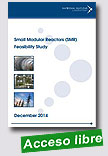 |
Small Modular Reactors (SMR) Feasibility Study
National Nuclear Laboratory (UK), December 2014, 64 p.
This Feasibility Study has been produced as a result of UK Government requesting the UK Industry view on Small Modular Reactors. Government asked Industry to undertake a review to determine a) whether SMRs are viable; b) the potential UK industry role; and c) the possible role that Government might play in that process.
This request was driven both by recognition from Government of a need for further industrial development, and for low carbon, secure and affordable energy supply.
|
The study was required to cover the following scope: 1. Global market assessment; 2. Technical assessment; 3. Investment in innovation; 4. Financial assessment (including cost reduction assessment); 5. UK commercial opportunity assessment.
Extraído de:
http://www.nnl.co.uk/media/1627/smr-feasibility-study-december-2014.pdf
|
 |
 |
Hanford Cleanup: Condition of Tanks May Further Limit DOE's Ability to Respond to Leaks and Intrusions
Government Accountability Office (GAO-US), Nov 25, 2014, 2014, 42 p.
DOE recently reported that nuclear waste is leaking from two of its underground storage tanks (T-111 and AY-102) at Hanford and that water was intruding into AY-102 and other tanks. Also, DOE has been experiencing delays in the construction of the WTP, a collection of facilities that are to treat the tank waste for disposal. These recently reported leaks and intrusions, |
combined with construction delays, have raised questions among regulators, the public, and Congress about the risks posed by continuing to store waste in the aging tanks.
GAO was asked to report on the tank waste cleanup program. This report examines: (1) the condition of the tanks, (2) actions DOE has taken or planned to respond to the recent tank leaks and water intrusions, and (3) the extent to which DOE's tank management plans consider the condition of the tanks and the delays in completing construction of the WTP. GAO obtained and reviewed relevant reports concerning the leaks, the status of the tanks, and the volumes of waste and available space in the tanks. GAO toured the site and interviewed DOE officials and responsible contractors.
Highlights Page
Extraído de: http://www.gao.gov/products/GAO-15-40
|
 |
|
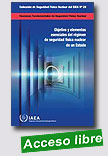
|
Objetivo y elementos esenciales del régimen de seguridad física nuclear de un Estado
Colección de Seguridad Física Nuclear del OIEA, 2014, 32 p.
La finalidad de la presente publicación es ayudar a los Estados Miembros a aumentar la seguridad física nuclear proporcionando a los encargados de formular políticas, los órganos legislativos, las autoridades competentes, las instituciones y las personas del ámbito nacional que participan en el establecimiento, la aplicación, el mantenimiento o la sostenibilidad del régimen de seguridad física nuclear de un Estado el objetivo y los elementos esenciales de ese régimen. Las Nociones Fundamentales constituyen la base de las publicaciones de la Colección de Seguridad Física Nuclear del OIEA.
|
Extraído de: http://www-pub.iaea.org/MTCD/Publications/PDF/Pub1590s_web.pdf
|
 |
| |
|
|
| |
| |
|
|
| |
|
|
|
| |
|
|
|
| |
|
|
|
|
|
